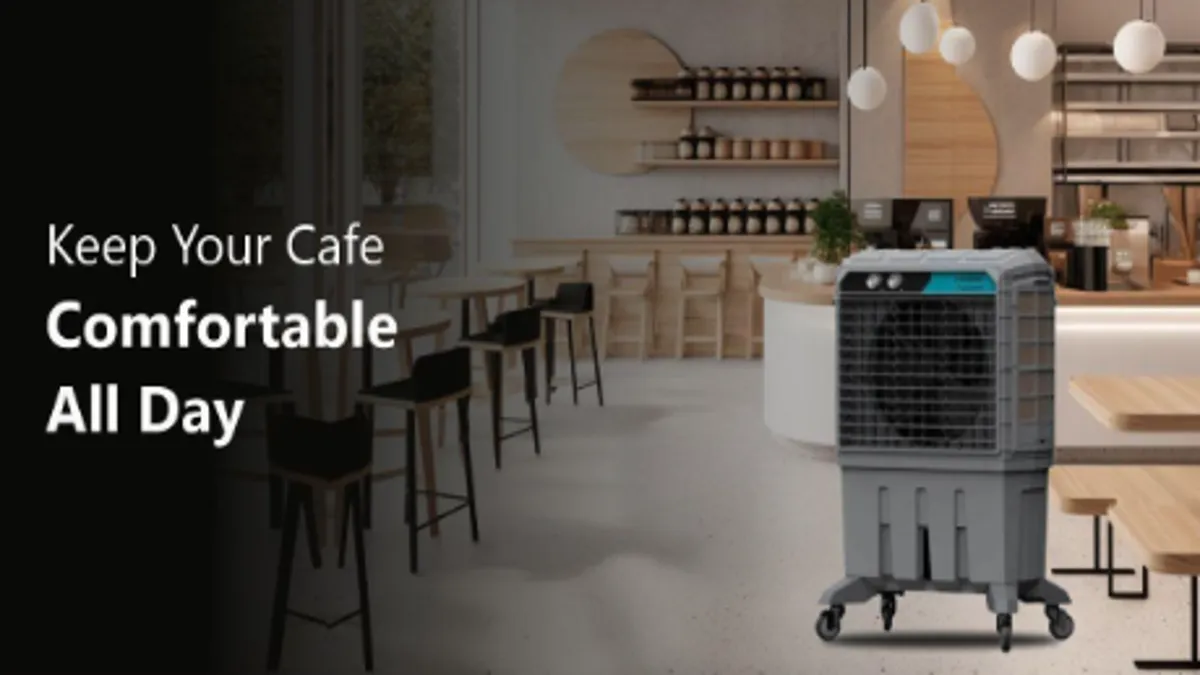I have walked into too many cafés in summer where you feel the heat hit as soon as the door opens. Fans hum, machines whir, the air feels thick. Running a full AC system all day isn’t always viable, too expensive, or too inflexible.
But you can keep things cool, comfortable, and calm. The trick is using cooling tech built for open spaces, not closed rooms.
A commercial cooler or big cooler made for industrial or large-scale use can transform how a café feels on a hot afternoon. Let us talk through how to pick one, make it work, and keep customers happy without freezing the budget.
Why Cafés Need Something Beyond Ordinary AC
Cafés are rough environments for cooling, doors open, people flow, and kitchens radiate heat. A regular AC ends up fighting all that, often cycling on and off. It wastes energy, and the comfort isn’t steady.
An industrial air cooler doesn’t seal you in like an AC. It takes the warm air around, runs it through damp cooling pads, and pushes it back out, fresher, softer. No need to close off the space. Leave the windows open, doors ajar; the café still stays cool and feels wide open, just like it should. Breezy, breathable, and alive.
Choosing a Cooler That Means Business
If you are going to buy a commercial cooler to handle café conditions, here’s what really matters:
- Air throw matters – You want that breeze to hit every corner, not just hover in front of the cooler.
- Big tank, less hassle – Something around 150 to 200 litres means you’re not running back with a hose every few hours.
- Good pads = smoother air – Honeycomb designs or multi-sided pads help the air move better and keep things quiet.
- Power & efficiency – The unit should cool efficiently without pulling excessive load.
- Mobility & build – Café layouts shift. Casters, sturdy frame, and ease of maintenance are big pluses.
There are a How These Coolers Beat ACs in Real Lifefew reasons why switching to the right cooler can outperform ACs in a café setting:
- Airflow over enclosure – Doors stay open. Fresh air keeps moving.
- Lower energy bills – Industrial coolers draw far less power than ACs.
- Better handle on heat sources – Coffee machines, ovens, and people generate heat; a powerful cooler can balance it.
- Easier upkeep – No refrigerant, fewer service calls. Just water, pad cleaning, occasional checks.
So while the industrial air cooler price might start higher than a small home unit, its long-term cost, flexibility, and comfort often outshine traditional AC setups.
One solid example is Symphony’s Jumbo 200 EX. This one’s built for serious cooling, with a 200-litre tank, honeycomb pads on three sides, and coverage that easily handles around 48 square metres.
It pulls about 260 watts, which is actually pretty reasonable for something its size. The mobility, large tank, and capability shown by the Jumbo 200 EX make it a genuine contender for cafés seeking serious cooling without incurring AC-level costs.
Making It Work Smoothly in Your Café
Even the best cooler needs some smart habits to perform well. Try these:
- Have a little space behind the cooler
- Keep the window open to allow air to circulate
- Make use of cool and clean water
- Rinse the pads weekly.
- Turn on a fan to spread the breeze.
With those small moves, the cooler doesn’t just do its job; it does it quietly and efficiently.
Price, Value & What to Expect
When you are contemplating the industrial air cooler price, it is a matter of the price tag. You should also consider the return on comfort. A model like the Jumbo 200 EX might cost more upfront. Still, when electricity, cooling efficiency, and customer satisfaction are factored in, it often pays for itself over a season or two.
If you are browsing online or comparing vendors, also check the big size cooler listings. Sometimes commercial coolers are listed with a premium because they are designed for larger airflow and heavier use.
Choosing Among Specific Models
Here are a few cooler types to compare, ones that align with café requirements:
- Symphony Jumbo 200 EX – Large 200-litre tank, 3-side honeycomb cooling, about 260 W consumption, suitable coverage around 48 m².
- Industrial/Ductable Units – Got a café with a split layout or some open patio space? It is smarter to use a couple of mid-to-large coolers for different zones instead of pushing one unit too hard.
- Mid-to-large commercial units – If your seating area is split or has open patios, use a combination of units to cover zones without overloading a single machine.
Final Thought
You don’t need an overly complex AC system to keep a café comfortable. With the right commercial cooler, designed for large spaces, you can maintain airflow, reduce electric load, and keep your patrons feeling relaxed instead of overheated.
When someone asks, “What cooling setup works without AC in an open café?”, your answer can be a well-sized, well-placed industrial or commercial cooler. Quiet, efficient, and designed to withstand heat and crowds.

